
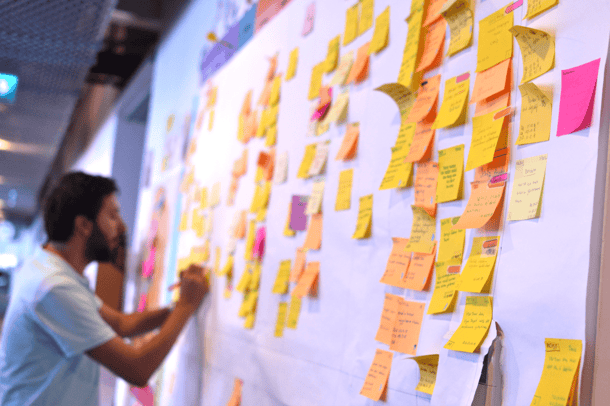
Think about the team you’re currently working in. Are you working Agile? When I ask that question, in most cases, I either get an (over)confident “YES!” or an unsure look and a question back: “Uhm… What do you mean exactly?”.
The people that responded confidently to the question above often start enumerating all the Agile Practices that they apply, be it Scrum, Kanban, retrospectives, stand-ups, demos or Test Driven Development. The hesitance of the other people mostly comes from the uncertainty of what Agile really is. When are you doing Agile? What is enough?
What exactly is working Agile?
Instead of seeing Agility as a rigid thing, it helps to see it as a maturity scale. Everyone and every team is working in an Agile manner, but not every team has reached the same level of maturity. Although the differences between teams or even individuals can be big, just like in Kaizen (Continuous Improvement) or Karate Belts, no one will ever reach the maximum. There’s always room for further improvement.

Speaking of improvement in working Agile: applying Agile Practices will generally improve your Agility. However, to keep that level of Agility from stagnating and to really grow, you’ll need more than copying and applying Agile Practices. The key is to build-in the Continuous Improvement mindset of consistently validating your way of working by the 12 Agile Principles.
Working Agile means that you continuously shape and improve your way of working by challenging it against the Agile Principles. Review your process frequently, using the Agile Principles as guidelines and the Agile Practices as inspiration!
Working Agile means that you continuously shape and improve your way of working by challenging it against the Agile Principles. Review your process frequently, using the Agile Principles as guidelines and the Agile Practices as inspiration!
The same is true for working Lean. It means that you continuously evaluate your workings by the 7 Principles from Lean Software Development.
These 19 principles can be a bit overwhelming, so inspired by these principles, I’ve created 7 steps to increase the Agility of your IT teams.
7 steps to increase Agility for new or existing teams
Think of the whole product development lifecycle for the product that you’re currently working on. It starts from the value you want to create for the customer or the assumption that you want to verify. It ends when the smallest solution for that outcome is delivered to the end customer. With that process in mind, let’s walk through 7 steps that will help you increase the Agility of your IT teams.
1. Visualize, visualize, visualize
Physically visualize what your teams are working on. Visualizing creates more transparency and lowers the barrier for others to join in on discussions. A visible workflow provides a structure for your collaboration and allows for more in-depth discussions. Here’s a small subset of ways to visualize whatever your team is working on:
- visualize the flow of work through a physical Kanban board, using sticky notes to represent the value you’re trying to create and lanes that represent the different steps that are required. Annotate the sticky notes to make impediments visible. Add avatars to make it what everyone in the team is working on.
- visualize the customer journey, product scope and releases by having the User Story Map visible in the team room. Alternatively, hang up the screen mock-ups or product screenshots on the wall. Draw up the personas and list the information you have about the end-users.
- trigger discussions on the design of your software by having printouts of the architecture diagrams in the team space. Visualize your domain model as well to ensure that everyone speaks the same language in these discussions.
- understand the users by visualizing insights about your product. Which features are being used and which not? How many users are facing errors?
- share a common goal by visualizing the progress toward the next milestone or MVP. Any blockages in your progress, e.g. a failure in your build pipeline, should be visible on a TV screen so everyone in the team immediately gets a heads up.
TIP: Next time you have a visitor, especially business stakeholders or sponsors, walk them through the visualizations in your team room. It will give them ‘Boots on the Ground’ and valuable insights about the project. It will be a boost in trust and confidence.
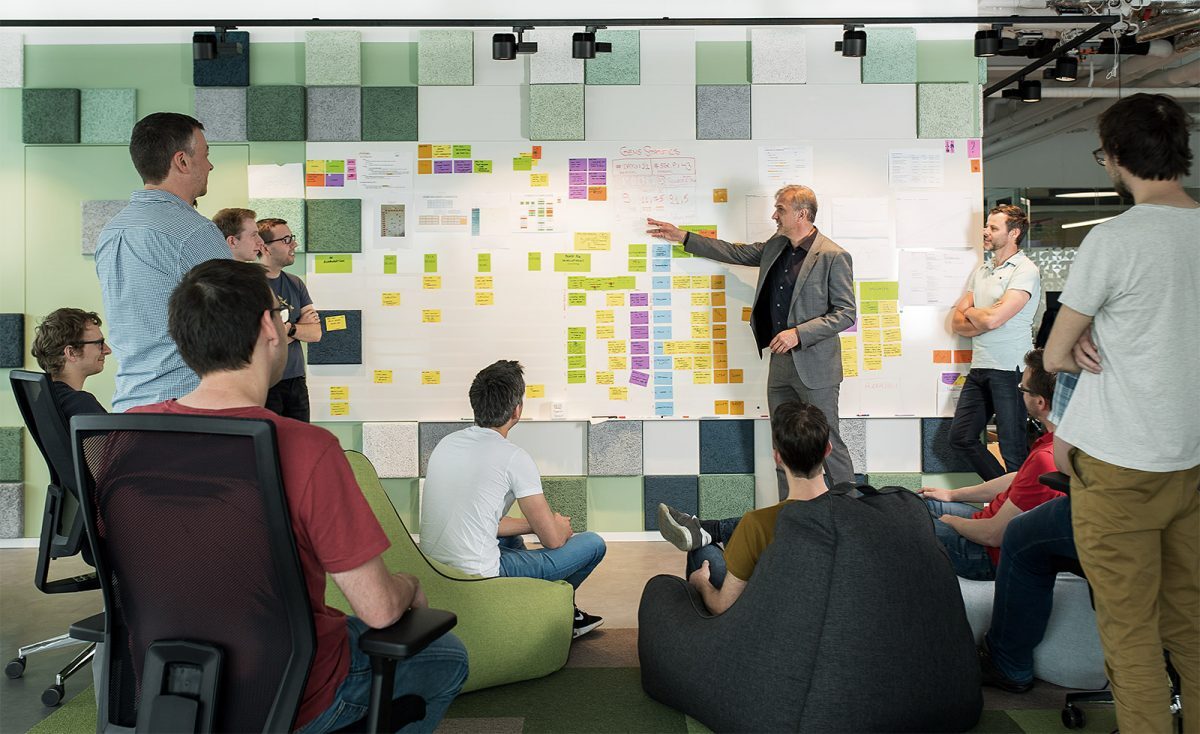
2. Collaboration > documentation
Building complex products requires multiple skills and multiple people. Instead of creating a document and handing it over to the next person the process, focus on collaboration and knowledge transfer in person. A document can be outdated quickly and require a lot of time to be kept up-to-date, while you’d rather spend resources on getting actual work done.
By sharing information face-to-face or participating in the brainstorm, everyone involved in the development process gains a lot more insight and will be able to do a better, more qualitative job. Here are some ideas:
- Regularly walk through the software design, architecture, customer journey and domain model with the whole team.
- Start the development of a story with a kick-off in which the analyst explains the story and its rationale face-to-face. Don’t forget to involve your dedicated tester if you have one!
- Pair programming is one of the best ways to learn from each other and to get a team that is fully aligned.
3. Fast feedback
Building a product is a team effort and requires a lot of work. We want to make sure that we are always doing the right thing with the right quality. The only way to know that you’re delivering valuable work is by providing – and getting – fast feedback. This feedback from the users on the features you’ve built, but also from the next person in your workflow. The faster the feedback, the smaller the chance the next person in line will be dissatisfied with the quality of work you’ve delivered before you improve. Here are a couple of ways you can build fast feedback loops:
- validate early mockups or rapid prototypes of the solution with the end users before starting actual development. Make it a habit in the team that everyone takes the time to play and test the product they’ve built to raise the empathy for the users.
- release fast and often. If you only release once a year, you’ll only know after one year whether it was worth the investment.
- do a technical review of every story at the end of the analysis to improve the quality of the analysis and avoid impediments during development. Also, do a technical review of every story that has been elaborated to improve the quality of the elaboration.
- validate the proposed architecture and consequent changes with the team to get early feedback on the feasibility. Additionally, frequently organize team retrospectives and retrospectives with the external stakeholders or collaborators to capture everyone’sfeedback on a regular basis. Use this feedback to improve your product or processes!
- make new features available to test users, stakeholders and the actual end users as fast as possible. Don’t forget to gather insights on how your users use the features you’ve previously built either.
4. Create a smooth workflow
To get your team to work like a well-oiled machine, you must ensure a smooth flow of work. A good flow means that planned work is delivered in a short amount of time. The investment made by the organization will be a lot lower before they see the resulting revenue.
To get to that point, start by making your epic and story workflow explicit and visible with a Kanban board. Next, improve it further. Here are some tips:
- define WIP (Work In Progress) limits for the different steps in your process.
- reduce the amount of ‘idling’ work by reducing the size of queues like ‘ready for development’, ‘to test’ and especially ‘waiting for deployment’. Don’t fall in the Scrum trap that your work finishes when you have implemented the story. The value is only delivered when the functionality is available in production.
- measure the total number of post-its that are ongoing in your flow, whether it’s a story in analysis, review, development or deployment. Is it increasing over time?
- apply the mantra: “Stop starting. Start finishing!” Don’t just pick up a new story for analysis or development if you can help a colleague to finish a story already in progress.
- swarm impediments, difficult stories or the initial project setup with the whole team. This will drastically reduce the lead time and ripple effects it would have.
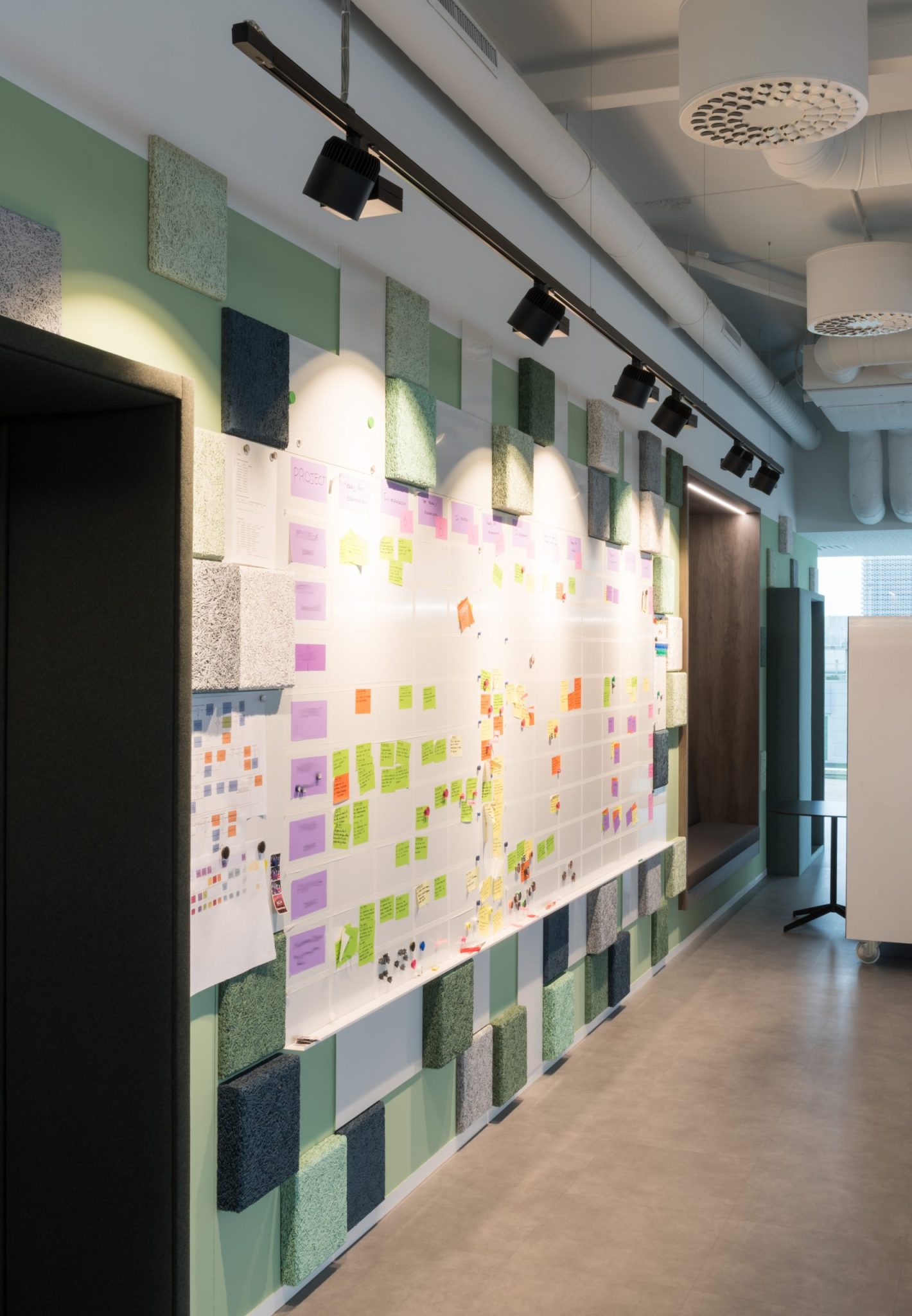
5. Split work in small parts
Splitting work in small parts allows your team to perform the least amount of work before actually starting to deliver functionality. Not only does this ensure a faster feedback loop, it also gives your team a feeling of accomplishment each time they finish a chunk of work.
Splitting work in small parts may seem like a daunting task at first. Here’s how to break up your work:
- split a big road map or product into small releases or Minimal Viable Product (MVP) increments based on the value it delivers, while taking the customer journey into account. Focus on bringing the first release live before starting work on the next release.
- split releases or MVPs into Epics or features that you need to deliver. Focus on finishing the most important Epics before starting work on the next Epic.
- split Epics / functionalities into Stories that can be implemented in 2 or 3 days tops. Focus on finishing ongoing stories before starting new stories.
After breaking the work down into Epics and Stories, set the priorities for the most important pieces for an MVP. This way, you always do the least amount of work to actually start delivering without missing the bigger picture.
6. Outcome > output
Continuously fine-tuning your way of working ensures a smooth workflow and high output. However, it’s more important to deliver the right outcome than a high output. Otherwise, you’re just spending money that the organization could’ve spent differently. So:
- evaluate what you’re working on. What is the value your project will deliver?
- focus on finishing work in progress instead of starting new work.
- make sure your team is finishing its work up to the point of bringing it live to the customer. All analysis work that is not yet developed, all code that has been written and is not in production, is still ‘waste’, since it doesn’t bring any value to the end users.
7. Quality & simplicity
Delivering quality needs to be everyone’s focus within the development process. Without that focus, you’re sure to deliver sub-optimal results to the next (or final) step in the process. Think of bugs, impediments, and confusion that end up costing more time and resources. To keep your focus optimal and avoid mishaps, always work on the simplest solution that meets the goals. A simpler solution is easier to understand, implement, explain and support.
- Only implement what you need now and what is in scope of the current story, spike, or epic. Any additional scope might result in work that will not be used.
- Every form of inefficiency in code or the way of working is technical debt that your organization will pay for eventually. Consistently remove small parts of this technical debt. By removing small parts, there is no short term negative impact on the performance of the team and you will still benefit from the mid and long term positive results.
- Use tooling like Sonar to review the quality of code. Make it a habit when implementing new features to reduce technical debt in the code that you are modifying. Continuous, small refactorings do not hinder the delivery of value, but a big rewrite, when the technical debt is too high, will have a huge impact.
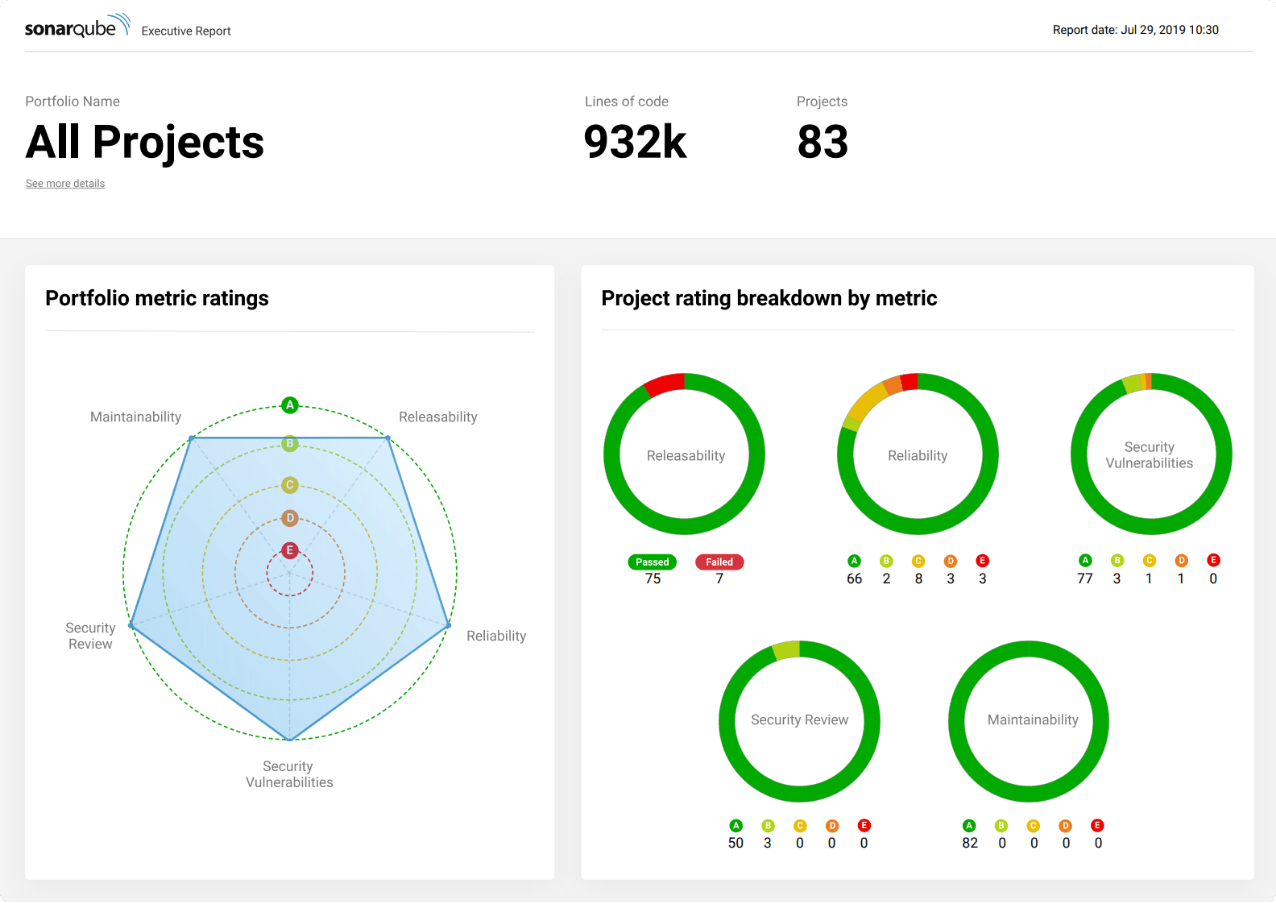
Takeaway
Continuously improving the way of working using the Agile en Lean principles as the guiding stars, is still not common in every (IT) organization. This blog post gives some actionable steps you can take to increase the Agility of your IT teams. You don’t have to start implementing all these steps right away, though. Start with a few that are manageable for your and your team, evaluate, improve and repeat. That’s how you’ll increase the Agility of your IT teams in an Agile way!
If you want more information, tips, guidelines or more, reach out to our Agile coaches and they’ll help you out!

What others have also read


In software development, assumptions can have a serious impact and we should always be on the look-out. In this blog post, we talk about how to deal with assumptions when developing software. Imagine…you’ve been driving to a certain place A place you have been driving to every day for the last 5 years, taking the same route, passing the same abandoned street, where you’ve never seen another car. Gradually you start feeling familiar with this route and you assume that as always you will be the only car on this road. But then at a given moment in time, a car pops up right in front of you… there had been a side street all this time, but you had never noticed it, or maybe forgot all about it. You hit the brakes and fortunately come to a stop just in time. Assumption nearly killed you. Fortunately in our job, the assumptions we make are never as hazardous to our lives as the assumptions we make in traffic. Nevertheless, assumptions can have a serious impact and we should always be on the look-out. Imagine… you create websites Your latest client is looking for a new site for his retirement home because his current site is outdated and not that fancy. So you build a Fancy new website based on the assumption that Fancy means : modern design, social features, dynamic content. The site is not the success he had anticipated … strange … you have build exactly what your client wants. But did you build what the visitors of the site want? The average user is between 50 – 65 years old, looking for a new home for their mom and dad. They are not digital natives and may not feel at home surfing on a fancy, dynamic website filled with twitter feeds and social buttons. All they want is to have a good impression of the retirement home and to get reassurance of the fact that they will take good care of their parents. The more experienced you’ll get, the harder you will have to watch out not to make assumptions and to double-check with your client AND the target audience . Another well known peril of experience is “ the curse of knowledge “. Although it sounds like the next Pirates of the Caribbean sequel, the curse of knowledge is a cognitive bias that overpowers almost everyone with expert knowledge in a specific sector. It means better-informed parties find it extremely difficult to think about problems from the perspective of lesser-informed parties. You might wonder why economists don’t always succeed in making the correct stock-exchange predictions. Everyone with some cash to spare can buy shares. You don’t need to be an expert or even understand about economics. And that’s the major reason why economists are often wrong. Because they have expert knowledge, they can’t see past this expertise and have trouble imagining how lesser informed people will react to changes in the market. The same goes for IT. That’s why we always have to keep an eye out, we don’t stop putting ourselves in the shoes of our clients. Gaining insight in their experience and point of view is key in creating the perfect solution for the end user. So how do we tackle assumptions …? I would like to say “Simple” and give you a wonderful oneliner … but as usual … simple is never the correct answer. To manage the urge to switch to auto-pilot and let the Curse of Knowledge kick in, we’ve developed a methodology based on several Agile principles which forces us to involve our end user in every phase of the project, starting when our clients are thinking about a project, but haven’t defined the solution yet. And ending … well actually never. The end user will gain new insights, working with your solution, which may lead to new improvements. In the waterfall methodology at the start of a project an analysis is made upfront by a business analist. Sometimes the user is involved of this upfront analysis, but this is not always the case. Then a conclave of developers create something in solitude and after the white smoke … user acceptance testing (UAT) starts. It must be painful for them to realise after these tests that the product they carefully crafted isn’t the solution the users expected it to be. It’s too late to make vigorous changes without needing much more time and budget. An Agile project methodology will take you a long way. By releasing testable versions every 2 to 3 weeks, users can gradually test functionality and give their feedback during development of the project. This approach will incorporate the user’s insights, gained throughout the project and will guarantee a better match between the needs of the user and the solution you create for their needs. Agile practitioners are advocating ‘continuous deployment’; a practice where newly developed features will be deployed immediately to a production environment instead of in batches every 2 to 3 weeks. This enables us to validate the system (and in essence its assumptions) in the wild, gain valuable feedback from real users, and run targeted experiments to validate which approach works best. Combining our methodology with constant user involvement will make sure you eliminate the worst assumption in IT: we know how the employees do their job and what they need … the peril of experience! Do we always eliminate assumptions? Let me make it a little more complicated: Again… imagine: you’ve been going to the same supermarket for the last 10 years, it’s pretty safe to assume that the cereal is still in the same aisle, even on the same shelf as yesterday. If you would stop assuming where the cereal is … this means you would lose a huge amount of time, browsing through the whole store. Not just once, but over and over again. The same goes for our job. If we would do our job without relying on our experience, we would not be able to make estimations about budget and time. Every estimation is based upon assumptions. The more experienced you are, the more accurate these assumptions will become. But do they lead to good and reliable estimations? Not necessarily… Back to my driving metaphor … We take the same road to work every day. Based upon experience I can estimate it will take me 30 minutes to drive to work. But what if they’ve announced traffic jams on the radio and I haven’t heard the announcement… my estimation will not have been correct. At ACA Group, we use a set of key practices while estimating. First of all, it is a team sport. We never make estimations on our own, and although estimating is serious business, we do it while playing a game: Planning poker. Let me enlighten you; planning poker is based upon the principle that we are better at estimating in group. So we read the story (chunk of functionality) out loud, everybody takes a card (which represent an indication of complexity) and puts them face down on the table. When everybody has chosen a card, they are all flipped at once. If there are different number shown, a discussion starts on the why and how. Assumptions, that form the basis for one’s estimate surface and are discussed and validated. Another estimation round follows, and the process continues till consensus is reached. The end result; a better estimate and a thorough understanding of the assumptions surrounding the estimate. These explicit assumptions are there to be validated by our stakeholders; a great first tool to validate our understanding of the scope.So do we always eliminate assumptions? Well, that would be almost impossible, but making assumptions explicit eliminates a lot of waste. Want to know more about this Agile Estimation? Check out this book by Mike Cohn . Hey! This is a contradiction… So what about these assumptions? Should we try to avoid them? Or should we rely on them? If you assume you know everything … you will never again experience astonishment. As Aristotle already said : “It was their wonder, astonishment, that first led men to philosophize”. Well, a process that validates the assumptions made through well conducted experiments and rapid feedback has proven to yield great results. So in essence, managing your assumptions well, will produce wonderful things. Be aware though that the Curse of Knowledge is lurking around the corner waiting for an unguarded moment to take over. Interested in joining our team? Interested in meeting one of our team members? Interested in joining our team? We are always looking for new motivated professionals to join the ACA team! {% module_block module "widget_3ad3ade5-e860-4db4-8d00-d7df4f7343a4" %}{% module_attribute "buttons" is_json="true" %}{% raw %}[{"appearance":{"link_color":"light","primary_color":"primary","secondary_color":"primary","tertiary_color":"light","tertiary_icon_accent_color":"dark","tertiary_text_color":"dark","variant":"primary"},"content":{"arrow":"right","icon":{"alt":null,"height":null,"loading":"disabled","size_type":null,"src":"","width":null},"tertiary_icon":{"alt":null,"height":null,"loading":"disabled","size_type":null,"src":"","width":null},"text":"View career opportunities"},"target":{"link":{"no_follow":false,"open_in_new_tab":false,"rel":"","sponsored":false,"url":{"content_id":229022099665,"href":"https://25145356.hs-sites-eu1.com/en/jobs","href_with_scheme":null,"type":"CONTENT"},"user_generated_content":false}},"type":"normal"}]{% endraw %}{% end_module_attribute %}{% module_attribute "child_css" is_json="true" %}{% raw %}{}{% endraw %}{% end_module_attribute %}{% module_attribute "css" is_json="true" %}{% raw %}{}{% endraw %}{% end_module_attribute %}{% module_attribute "definition_id" is_json="true" %}{% raw %}null{% endraw %}{% end_module_attribute %}{% module_attribute "field_types" is_json="true" %}{% raw %}{"buttons":"group","styles":"group"}{% endraw %}{% end_module_attribute %}{% module_attribute "isJsModule" is_json="true" %}{% raw %}true{% endraw %}{% end_module_attribute %}{% module_attribute "label" is_json="true" %}{% raw %}null{% endraw %}{% end_module_attribute %}{% module_attribute "module_id" is_json="true" %}{% raw %}201493994716{% endraw %}{% end_module_attribute %}{% module_attribute "path" is_json="true" %}{% raw %}"@projects/aca-group-project/aca-group-app/components/modules/ButtonGroup"{% endraw %}{% end_module_attribute %}{% module_attribute "schema_version" is_json="true" %}{% raw %}2{% endraw %}{% end_module_attribute %}{% module_attribute "smart_objects" is_json="true" %}{% raw %}null{% endraw %}{% end_module_attribute %}{% module_attribute "smart_type" is_json="true" %}{% raw %}"NOT_SMART"{% endraw %}{% end_module_attribute %}{% module_attribute "tag" is_json="true" %}{% raw %}"module"{% endraw %}{% end_module_attribute %}{% module_attribute "type" is_json="true" %}{% raw %}"module"{% endraw %}{% end_module_attribute %}{% module_attribute "wrap_field_tag" is_json="true" %}{% raw %}"div"{% endraw %}{% end_module_attribute %}{% end_module_block %}
Read more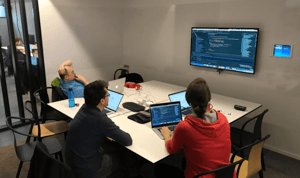
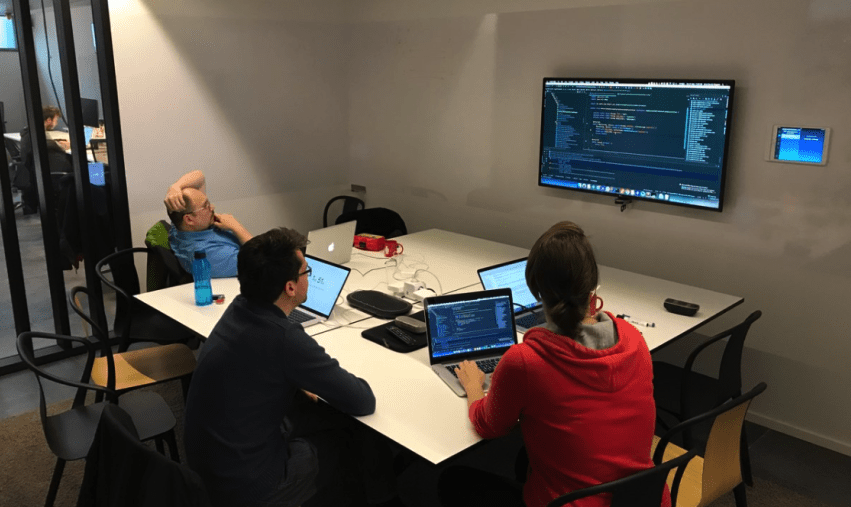
ACA does a lot of projects. In the last quarter of 2017, we did a rather small project for a customer in the financial industry. The deadline for the project was at the end of November and our customer was getting anxious near the end of September. We were confident we could pull off the job on time though and decided to try out an experiment. We got the team together in one room and started mob programming . Mob what? We had read an article that explains the concept of mob programming. In short, mob programming means that the entire team sits together in one room and works on one user story at a time. One person is the ‘driver’ and does the coding for a set amount of time. When that time has passed, the keyboard switches to another team member. We tried the experiment with the following set-up: Our team was relatively small and only had 4 team members. Since the project we were working on was relatively small, we could only assing 4 people. The user stories handled were only a part of the project. Because this was en experiment, we did not want the project - as small as it was - to be mobbed completely. Hence, we chose one specific epic and implemented those user stories in the mob. We did not work on the same computer. We each had a separate laptop and checked in our code to a central versioning system instead of switching the keyboard. This wasn't really a choice we made, just something that happened. We switched every 20 minutes. The article we referred to talks about 12, but we thought that would be too short and decided to go with 20 minutes instead. Ready, set, go! We spent more than a week inside a meeting room where we could, in turn, connect our laptops to one big screen. The first day of the experiment, we designed. We stood at the whiteboard for hours deciding on the architecture of the component we were going to build. On the same day, our mob started implementing the first story. We really took off! We flew through the user story, calling out to our customer proxy when some requirements were not clear. Near the end of the day, we were exhausted. Our experiment had only just started and it was already so intense. The next days, we continued implementing the user stories. In less than a week, we had working software that we could show to our customer. While it wasn’t perfect yet and didn’t cover all requirements, our software was able to conduct a full, happy path flow after merely 3 days. Two days later, we implemented enhancements and exception cases discussed through other user stories. Only one week had passed since our customer started getting anxious and we had implemented so much we could show him already. Finishing touches Near the end of the project, we only needed to take care of some technicalities. One of those was making our newly-built software environment agnostic. If we would have finished this user story with pair programming, one pair would know all the technical details of the software. With mob programming, we did not need to showcase it to the rest of the team. The team already knew. Because we switched laptops instead of keyboards, everyone had done the setup on their own machine. Everyone knew the commands and the configuration. It was knowledge sharing at its best! Other technicalities included configuring our software correctly. This proved to be a boring task for most of the navigators. At this point, we decided the mob experiment had gone far enough. We felt that we were not supposed to do tasks like these with 4 people at the same time. At least, that’s our opinion. Right before the mob disbanded, we planned an evaluation meeting. We were excited and wanted to do this again, maybe even at a bigger scale. Our experience with mob programming The outcome of our experiment was very positive. We experienced knowledge sharing at different levels. Everyone involved knew the complete functionality of the application and we all knew the details of the implementation. We were able to quickly integrate a new team member when necessary, while still working at a steady velocity. We already mentioned that we were very excited before, during and after the experiment. This had a positive impact on our team spirit. We were all more engaged to fulfill the project. The downside was that we experienced mob programming as more exhausting. We felt worn out after a day of being together, albeit in a good way! Next steps Other colleagues noticed us in our meeting room programming on one big screen. Conversations about the experiment started. Our excitement was contagious: people were immediately interested. We started talking about doing more experiments. Maybe we could do mob programming in different teams on different projects. And so it begins… Have you ever tried mob programming? Or are you eager to try? Let’s exchange tips or tricks! We’ll be happy to hear from you!
Read more

OutSystems: a catalyst for business innovation In today's fast-paced business landscape, organisations must embrace innovative solutions to stay ahead. There are a lot of strategic technological trends that address crucial business priorities such as digital immunity, composability, AI, platform engineering, Low-Code , and sustainability. OutSystems , the leading Low-Code development platform , has become a game-changer in supporting organisations to implement these trends efficiently and sustainably. OutSystems enhances cyber security As organisations increasingly rely on digital systems, cyber threats pose a significant risk. Additionally, digital engagement with customers, employees, and partners, plays a vital role in a company's well-being. The immunity and resilience of an organisation is now as strong and stable as its core digital systems. Any unavailability can result in a poor user experience, revenue loss, safety issues, and more. OutSystems provides a robust and secure platform that helps build digital immune systems , safeguarding against evolving cybersecurity challenges. With advanced threat detection, continuous monitoring, secure coding practices , and AI code-scanning, OutSystems ensures applications are resilient and protected. Furthermore, the platform covers most of the security aspects for project teams, enabling them to focus on delivering high value to end customers while best practices are recommended by the platform through code analysis using built-in patterns. OutSystems simplifies cloud-native infrastructure management Cloud-native architecture has emerged as a vital component for modern application development. The OutSystems Developer Cloud Platform enables teams to easily create and deploy cloud-native applications, leveraging the scalability and flexibility of cloud infrastructure through Kubernetes . It allows companies to: Optimise resource utilisation Auto-scale application runtimes Reduce operational costs Adopt sustainable practices (serverless computing, auto-scaling, …) All this without the need for prior infrastructure investment nor the deep technical knowledge required to operate it and the typical burdens associated. OutSystems: gateway to AI and automation AI and hyper-automation have become essential business tools for assisting in content creation, virtual assistants, faster coding, document analysis, and more. OutSystems empowers professional developers to be more productive by infusing AI throughout the application lifecycle. Developers benefit from AI-assisted development, natural language queries, and even Generative AI. Once ready with your development, transporting an app to the test or production environment only takes a few clicks. The platform highly automates the process and even performs all the necessary validations and dependency checks to ensure unbreakable deployments. OutSystems seamlessly integrates with AI capabilities from major cloud providers like Amazon, Azure (OpenAI), and Google, allowing project teams to leverage generative AI, machine learning, natural language processing , and computer vision . By making cutting-edge technologies more accessible, OutSystems accelerates digital transformation and creates sustainable competitive advantages. OutSystems enables composable architecture for agility Composable architecture and business apps, characterised by modular components, enable rapid adaptation to changing business needs. OutSystems embraces this trend by providing a cloud-native Low-Code platform using and supporting this type of architecture. It enables teams to easily build composable technical and business components. With the visual modelling approach of Low-Code, a vast library of customizable pre-built components and a micro-service-based application delivery model, OutSystems promotes high reusability and flexibility. This composable approach empowers organisations to: Respond rapidly to changing business needs Experiment with new ideas Create sustainable, scalable, and resilient solutions OutSystems enables the creation of business apps that can be easily integrated, replaced, or extended, supporting companies on their journey towards composability and agility. OutSystems facilitates self-service and close collaboration Platform engineering, which emphasises collaboration between development and operations teams, drives efficiency and scalability. OutSystems provides a centralised Low-Code platform embracing this concept at its core by being continuously extended with new features, tools and accelerators. Furthermore the platform facilitates the entire application development lifecycle until operations . Including features like Version control Automated deployment Continuous integration and delivery (CI/CD) Logging Monitoring Empowering organisations to adopt agile DevOps practices. With OutSystems, cross-functional teams can collaborate seamlessly, enabling faster time-to-market and improved software quality. By supporting platform engineering principles, OutSystems helps organisations achieve sustainable software delivery and operational excellence. OutSystems drives sustainability in IT OutSystems leads the way in driving sustainability in IT through its green IT Low-Code application development platform and strategic initiatives. By enabling energy-efficient development, streamlining application lifecycle management, leveraging a cloud-native infrastructure , and promoting reusability , OutSystems sets an example for the industry. Organisations can develop paperless processes, automate tasks, modernise legacy systems, and simplify IT landscapes using OutSystems 3 to 4 times faster, reducing overall costs and ecological footprint. By embracing OutSystems, companies can align their IT operations with a greener future, contribute to sustainability, and build a more resilient planet. Wrapping it up In the era of digital transformation and sustainability, OutSystems is a powerful ally for organisations, delivering essential business innovations, such as … High-performance Low-Code development Cloud-native architecture AI and automation Robust security measures Collaborative DevOps practices Take the OutSystems journey to align with IT trends, deliver exceptional results, and contribute to a sustainable and resilient future. Eager to start with OutSystems? Let us help
Read moreWant to dive deeper into this topic?
Get in touch with our experts today. They are happy to help!

Want to dive deeper into this topic?
Get in touch with our experts today. They are happy to help!

Want to dive deeper into this topic?
Get in touch with our experts today. They are happy to help!

Want to dive deeper into this topic?
Get in touch with our experts today. They are happy to help!

